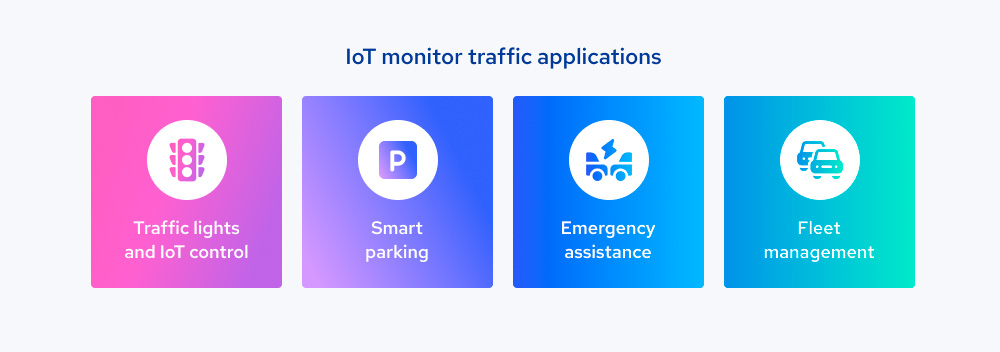
Getting around busy city streets can be tough nowadays. Traffic jams and safety issues make it a daily struggle. IoT-based traffic management system is here to help. It uses things like sensors, cameras, and smart automation to change the way we get along with traffic. Bringing these technologies to our streets makes traffic jams go away and keeps us safer.
Smart traffic management systems offer an immediate and cost-effective solution to enhance safety and traffic flow on city streets. Cities can swiftly realize improvements by integrating these technology solutions into existing traffic ecosystems and intersections. Upgrading these systems leads to significant cost savings and enhances system reliability, providing an excellent return on investment (ROI). The improvement of such systems presents a proactive approach for cities, offering better traffic management within their intelligent transportation systems (ITS) infrastructure.
In this article, you will find out more about IoT traffic control technology, its use, and smart traffic management systems using IoT.
Demand for smart traffic management
Public infrastructure budgets are often tight. Building new roads and bridges can cost a lot. Here’s how IoT traffic control systems can help municipal and regional transportation departments. These systems offer a quick and cost-effective solution. It’s a smart upgrade that helps cities get more out of what they already have.
Cities continue to grow and change, and so does the complexity of IoT traffic management. The traditional methods always result in traffic jams, delays, and stressed-out commuters. IoT-based traffic management system is a solution designed to handle these issues head-on with its dynamic and responsive approach.
Despite its immense potential, this innovative system faces challenges. The initial costs of realization and the need to raise public awareness are challenges that need addressing. However, as technology develops, we can expect even more sophisticated features that will elevate the commuting experience to new heights.
The market for intelligent traffic management is projected to reach $19.91 billion by 2028, showing a compound annual growth rate of 10.1%. The surge in demand and the rising adoption of IoT traffic solutions are closely tied to the thriving of smart city technology. Notably, there are over 250 smart city projects underway worldwide.
In essence, a smart traffic management system using IoT is a solution in the evolving landscape of urban mobility with a promising impact on the challenges posed by ever-changing cities.
IoT and smart city traffic
In the world of smart traffic management using IoT, sensors play a vital role by supplying the essential data for analysis by intelligent systems. These systems leverage a variety of integrated sensors, for example, temperature sensors and air quality sensors. The volume of data generated by intelligent transportation systems makes it imperative to incorporate both cloud computing and edge processing for effective analysis and decision-making.
As cities around the world experience population growth, their municipal infrastructure faces increasing strain. The unstopping issue of traffic jams is on the rise. Escalating urban growth emphasizes the need to align with sustainability goals while reevaluating traffic management strategies.
The incorporation of traffic technology not only brings significant cost savings but also enhances system reliability. Smart traffic management systems could potentially save cities $277 billion while reducing emissions and congestion by 2025.
The urgent demand for advanced communication and network technologies is driving the adoption of smart traffic control through the capabilities of IoT.
Smart traffic applications
The government can enhance city operations and infrastructure by deploying IoT sensors and tracking devices on roads to record, analyze, and share real-time data. An intelligent IoT traffic control system leveraging IoT capabilities encompasses a multitude of factors and use cases.

Traffic lights and IoT control
IoT traffic signals employ an array of sensors for real-time iot traffic monitoring. The primary aim is to minimize stop time for vehicles. Thanks to IoT technology, traffic lights can communicate with each other, adjusting to changing traffic conditions. The result is a reduction in time spent in traffic jams and a positive impact on reducing carbon emissions.
Smart parking
Smart meters and mobile apps have simplified access to parking spaces by providing instant notifications. Drivers receive signals when a parking spot becomes available, which allows them to reserve a parking spot instantly. The app also offers straightforward directions to the parking spot and a convenient online payment option.
Emergency assistance
In situations such as car accidents late at night or in isolated locations, an IoT-based traffic management system plays an important role in expediting emergency response mechanisms. The road sensors detect any accidents and immediately report the issue to the traffic management system. The system forwards the request to the relevant authorities, like medical technicians, police officers, and fire departments, by ensuring enhanced responsiveness and timely intervention.
Commute assistance
IoT sensors can transform into a specialized app that can offer route suggestions. They provide advance notice of accidents or traffic jams and recommend the optimal time to depart. This is possible thanks to a robust algorithm that aims to minimize driving time through intelligent traffic lights.
Fleet management
Delivery trucks or essential local government vehicles like fire trucks and school buses need effective fleet management for seamless operations. Ensuring that vehicles reach their destinations safely, efficiently, and at minimal cost is a top priority. By employing IoT sensors for safer aspects that can be monitored, signaling drivers to potential issues. Additionally, real-time tracking by IoT devices allows for route optimization and enables monitoring of vehicles remotely from a computer.
Vehicle traffic connectivity
As technology continues to advance, organizations and municipalities are navigating the present while at the same time keeping an eye on the future.
One notable innovation with a significant impact on smart traffic is connected vehicle technology. Currently undergoing trials at test sites, this technology will facilitate vehicle-to-intersection communications and automated braking. As network speeds increase, the capability to make automated decisions for driver and pedestrian safety will see a significant improvement.
Many smart cities proactively integrate infrastructure technology to be well-prepared for the earliest availability of connected vehicle solutions. Looking ahead, technologies like machine learning will also find applications, undergoing testing to identify objects and make rapid decisions.
Conclusion
To sum up, IoT in traffic management emerges not just as a technological advancement but as a promising solution to the issues of traffic congestion, safety concerns, and urban efficiency. By integrating sensors, automation, and data analysis, IoT traffic management offers the potential to transform our cities into more navigable, safer, and environmentally friendly spaces.
The ongoing development and adoption of these intelligent traffic solutions hold the key to creating a more connected, efficient, and sustainable urban landscape for generations to come.